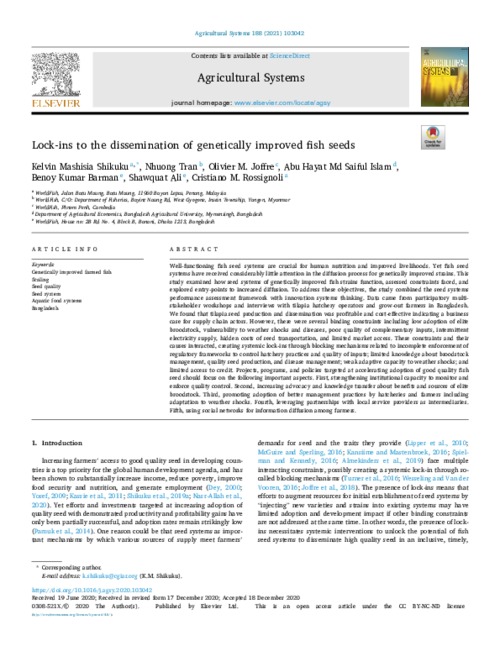Lock-ins to the dissemination of genetically improved fish seeds

Well-functioning fish seed systems are crucial for human nutrition and improved livelihoods. Yet fish seed systems have received considerably little attention in the diffusion process for genetically improved strains. This study examined how seed systems of genetically improved fish strains function, assessed constraints faced, and explored entry-points to increased diffusion. To address these objectives, the study combined the seed systems performance assessment framework with innovation systems thinking. Data came from participatory multistakeholder workshops and interviews with tilapia hatchery operators and grow-out farmers in Bangladesh. We found that tilapia seed production and dissemination was profitable and cost-effective indicating a business case for supply chain actors. However, there were several binding constraints including low adoption of elite broodstock, vulnerability to weather shocks and diseases, poor quality of complementary inputs, intermittent electricity supply, hidden costs of seed transportation, and limited market access. These constraints and their causes interacted, creating systemic lock-ins through blocking mechanisms related to incomplete enforcement of regulatory frameworks to control hatchery practices and quality of inputs; limited knowledge about broodstock management, quality seed production, and disease management; weak adaptive capacity to weather shocks; and limited access to credit. Projects, programs, and policies targeted at accelerating adoption of good quality fish seed should focus on the following important aspects. First, strengthening institutional capacity to monitor and enforce quality control. Second, increasing advocacy and knowledge transfer about benefits and sources of elite broodstock. Third, promoting adoption of better management practices by hatcheries and farmers including adaptation to weather shocks. Fourth, leveraging partnerships with local service providers as intermediaries. Fifth, using social networks for information diffusion among farmers.
Permalink
Date Available
Type
Publisher
Countries
ISSN
0308-521X
Copyright
CC-BY-NC-ND-4.0
Research Themes
Topics
Language